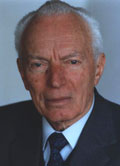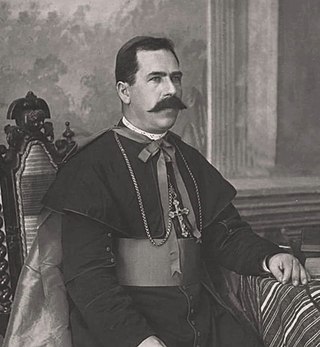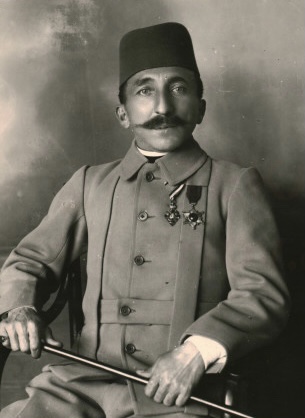Related Research Articles

Gollak or Gallap is a mountainous and ethnographic region in the eastern part of Kosovo and partially in Serbia, bordering the Llap region to the North, the Kosovo field to the west, the Anamorava valley to the south and straddling along the border with Serbia. The cities of Prishtina and Gjilan in Kosovo are located by the mountains. The highest peak, Gollak-Lisica, has an elevation of 1,186 m (3,891 ft) above sea level. Gollak itself is split into Upper Gollak and Lower Gollak.

The Diocese of Skopje, is a Latin Church diocese of the Catholic church in North Macedonia. From the 4th century to 1656, when it was renamed to Archdiocese of Skopje, it was known as the Archdiocese of Dardania. In 1969 along with the Roman Catholic Diocese of Prizren, it formed the Diocese of Skopje-Prizren. In 2000 it became a suffragan diocese of the Archdiocese of Vrhbosna, and the bishop is Kiro Stojanov, appointed in 2005.

Mark Krasniqi was an Kosovar Albanian ethnographist, publicist, writer and translator who did most of his work while residing in Yugoslavia.

The Catholic Church has a population in Kosovo of approximately 65,000 in a region of roughly 2 million people.

Parashqevi Qiriazi was an Albanian teacher of the Qiriazi family who dedicated her life to the Albanian alphabet and to the instruction of written Albanian language. She was a woman participant at the Congress of Manastir, which decided the form of the Albanian alphabet, and the founder of the Yll' i Mengjesit, a women's association. Parashqevi was also a participant in the Paris Peace Conference, 1919 as a member of the Albanian-American community. She was the sister of Sevasti Qiriazi, who was the director of the first Albanian School for girls in Korça, opened in 1891.

Gjergj Qiriazi was an Albanian patriot, author, educator, translator, Protestant Bible distributor, organizer of the First Congress of Monastir (1908), and activist of the Albanian National Awakening.

Lazër Mjeda (1869–1935) was an Albanian prelate of the Roman Catholic Church, and a member of the Mjeda family.

The Black Society for Salvation was a secret Albanian nationalist society established in 1909. Its main task was to organize uprisings in southern Albania and Macedonia struggling for the unification of the four Ottoman vilayets with the substantial Albanian population into one autonomous political unit with its own government and parliament. The members of the society considered the armed rebellions as legitimate means for achieving their aims.

The Sanjak of Scutari or Sanjak of Shkodra was one of the sanjaks of the Ottoman Empire. It was established after the Ottoman Empire acquired Shkodra after the siege of Shkodra in 1478–9. It was part of the Eyalet of Rumelia until 1867, when it became a part, together with the Sanjak of Skopje, of the newly established Scutari Vilayet. In 1912 and the beginning of 1913 it was occupied by members of the Balkan League during the First Balkan War. In 1914 the territory of Sanjak of Scutari became a part of the Principality of Albania, established on the basis of the peace contract signed during the London Conference in 1913.
The Sanjak of Niš was one of the sanjaks of the Ottoman Empire and its county town was Niš. It was composed of the kazas of Niš (Niş), Pirot (Şehirköy), Leskovac (Leskofça), Vranje (İvranye), Kuršumlija (Kurşunlu), Prokuplje (Ürküp) and Tran (Turan).

The Albanian revolt of 1911 or the Malësori uprising of 1911 was one of many Albanian revolts in the Ottoman Empire and lasted from 24 March 1911 until 4 August 1911 in the region of Malësia.
Classical music in Kosovo refers to the art music cultivated in Kosovo. The roots of classical music in Kosovo are found in the 1940s and include the time period from the times when Kosovo was part of Yugoslavia to this day. It can be said that there is a tradition of classical music in Kosovo, however, compared to other Balkan countries and especially European countries this tradition is younger. Classical music in Kosovo reaches back about 70 years. Even though in a short period of time, this music has evolved, passing through generations of composers and artists. In his book Albanian: Zhvillimi i stileve në veprat e kompozitorëve shqiptarë të Kosovës, Engjëll Berisha comments:
"The diversity of styles in Albanian music [of Kosovo], its national patterns with sound idea-aesthetic foundations are a characteristic of the European musical reality, so many many works are of interest abroad, too, because during this relatively short period Albanian classical music in Kosovo has compensated for the delay in its development."

Hysni Curri (?–1925) was a Kosovar Albanian military figure and a prominent leader of the Kachak movement and the Committee for the National Defence of Kosovo.

Krasniqi is a historical Albanian tribe and region in the Accursed Mountains in northeastern Albania, bordering Kosovo. The region lies within the Tropoje District and is part of a wider area between Albania and Kosovo that is historically known as Gjakova highlands. Krasniqi stretches from the Valbona river in the north to Lake Fierza in the south and includes the town Bajram Curri. Members of the Krasniqi tribe are also found in Kosovo and Northern Macedonia.

Desovo is a village in the municipality of Dolneni, North Macedonia.

Patiška Reka is a village in the municipality of Sopište, North Macedonia.
Shpend Dragobia was an Albanian warrior during the pre-Albanian declaration of independence period and later. He was the son of Bali Arif Bisheva, a member of the League of Prizren and fighter during the Albanian uprising of 1845-1862 against the German-born Marshal Mehmed Ali Pasha. Shpend Dragobia grew up to be a patriotic figure known for his wisdom, character and bravery.
Gaspër Krasniqi, also referred as Joshtar Krasnik, Gashpar Krasnik, or Don Karlo Krasnik, was an Albanian Roman Catholic priest who served as Vicar Apostolic of the Diocese of Skopje.
Gjonaj is a village in Prizren municipality, Kosovo. The village lies within the Has region.
Mihael Summa or Mikel Suma was the Albanian Catholic Archbishop of Skopje from 1728 to 1743, having succeeded Peter Karagić.
References
- 1 2 Archbishop Matthaeus Crasnich
- ↑ Thede Kahl; Izer Maksuti; Albert Ramaj (2006). Die Albaner in der Republik Makedonien: Fakten, Analysen, Meinungen zur interethnischen Koexistenz. Lit. p. 24. ISBN 978-3-8258-0030-7.
- ↑ Arshi Pipa; Sami Repishti (1984). Studies on Kosova. East European Monographs. p. 32. ISBN 978-0-88033-047-3.
- ↑ Reshat Nexhipi (1996). Shtypja dhe rezistenca shqiptare në Maqedoni nëpër shekuj: tema të rralla të nxjerra nga bibliografia dhe biografia personale. p. 64.
- ↑ Jašar Redžepagić (1970). Zhvillimi i arësimit dhe i sistemit shkollor të kombësisë shqiptare në teritorin e Jugosllavisë së sotme deri në vitin 1918. Enti i teksteve dhe i mjeteve mësimore i Krahinës Socialiste Autonome të Kosovës. p. 152.
- ↑ Pius Gams (1873). Series episcoporum ecclesiae catholicae: quotquot innotuerunt a beato Petro Apostolo. Manz. pp. 417–.
- ↑ Gaetano Moroni (1853). Dizionario di erudizione storico-ecclesiastica da s. Pietro sino ai nostri giorni. Tipogr. Emiliana. pp. 234–.
- ↑ "Archbishop Matthaeus Crasnich [Catholic-Hierarchy]". www.catholic-hierarchy.org. Retrieved 2023-05-28.